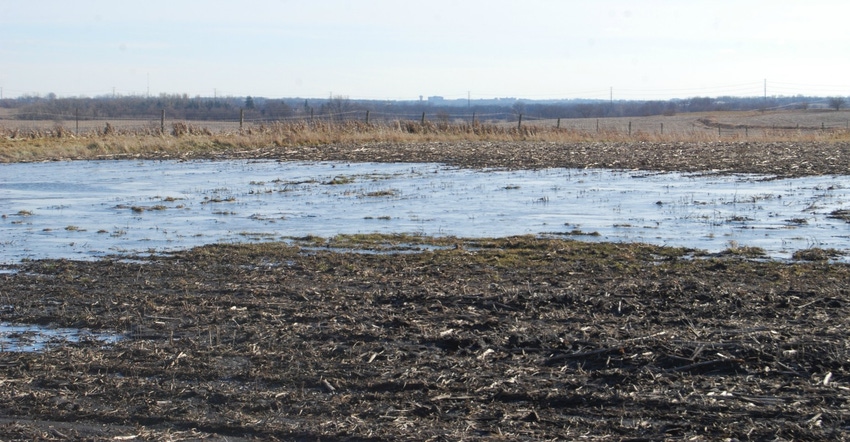April 2, 2019

Recent flooding has forced many crop producers to re-examine their timeline for planting this spring. Planting a crop early provides the best chance for optimum yields, but what happens when tillage and planting are not able to be accomplished as early as desired? Here’s a list of frequently asked questions regarding prevented planting and the options farmers have.
When is prevented planting available? Prevented planting must be due to an insured cause of loss that is general in the surrounding area and that prevents other producers from planting acreage with similar characteristics. Failure to plant when other producers in the area were planting will result in denial of the prevented planting claim.
There’s also a 20/20 rule: A minimum of 20 acres or 20% of the unit must be affected. Total acres of planted and prevented planted acres can’t exceed the total cropland acres. Prevented planting claims in Iowa must be filed with your crop insurance agent by June 28 for corn and July 13 for soybeans. Prevented planting acres must be reported on Farm Service Agency acreage report Form 578. That deadline to file that form in Iowa is July 15.
When is prevented planting not available? On ground that is insured through a New Breaking Written Agreement, Conservation Program Reserve land that is in its first year out of CRP, on ground where a pasture or forage crop is in place during the time of planting, when other producers in the area are able to plant, and on county-based crop insurance area policies such as Area Yield Protection (AYP) and Area Risk Protection Insurance (ARPI).
How much do I get paid for prevented planting? On corn it’s 55% of the initial revenue guarantee and 60% on soybeans.
An example payment for corn would look like the following: 190 bushels actual production history (APH) × 80% x $4 per bushel = $608 initial revenue guarantee × 55% = $334.40 per acre prevented planting (PP) payment.
For soybeans, an example is: 55 bushels APH x 80% × $9.54 per bushel = $419.76 initial revenue guarantee × 60% = $251.86 per acre PP payment.
Payments for prevented planting use the projected price (new crop futures price average in February).
How are eligible acres for prevented planting determined? The insurance company considers each of the insured’s crops in each county. It looks at the maximum number of acres reported for insurance and certified in any of the four most recent crop years. The acres must have been planted in one of the last three crop years.
What happens if you are prevented from planting and there are not enough eligible acres for the crop being claimed? When the insured runs out of acreage eligibility for one crop, the remaining prevented planting acres will be “rolled” to another crop, such as corn to soybeans.
What happens to my APH if I take prevented planting? The insured farmer who receives prevented planting on a crop does not have to report the actual yield for the year. Generally, prevented planting will not impact the APH yield in future years, unless a second crop is planted on prevented planting acres.
What happens if the first crop is prevented planting, but the second crop is planted? If the second crop is planted, it must be insured if there was insurance for that crop elected on or before March 15, 2019. The second crop must have been planted after June 25 for corn and July 10 for soybeans. If the insured farmer plants a second crop they will still receive 35% of the indemnity for the prevented planting crop and pay only 35% of the premium.
Planting a second crop on prevented planting ground affects the following year’s APH:
First crop. You receive 60% of the approved yield (190 bu. per acre APH x 60% = 114 bu. per acre).
Second crop. Actual yields are used for APH.
What will crop insurance adjusters need to do for prevented planting claims? Visually inspect all prevented planting acres to determine:
acres are within 5% of what was on the acreage report
whether the acres are left idle, or whether a cover crop or second crop has been planted
what the cause of loss was, and if it is general to the area
determine eligible acres
roll acres to other crops if insured is short of eligible acres for reported prevented planting crop
What are the deadlines for filing prevented planting in Iowa? These dates vary by state but tend to be three days after the last day of the late planting period.
In Iowa, the deadline for filing prevented planting with your crop insurance agent is June 28 for corn and July 13 for soybeans.
Acreage reporting deadline is July 15.
Prevented planting acres listed on your acreage report (FSA Form 578) should match the information provided to your crop insurance agent in order to qualify for a full indemnity payment.
Work with your crop insurance agent well in advance of these dates regarding a prevented planting claim and whether a cover crop or a second crop will be planted.
If I have to leave some of my acres unplanted (prevented planting), will they still count toward my eligibility for enterprise units? Only planted acres are considered when determining eligibility for enterprise units. (To qualify for enterprise units on crop insurance policy, at least the smaller of 20 acres or 20% of planted acres must be in two or more different township sections).
For example, a farm with 200 acres each in two sections would normally qualify for enterprise units. However, if fewer than 20 acres are planted in one of the sections, the farm would no longer qualify. Possible increases in crop insurance premiums due to a change in unit designation should be considered when deciding whether or not to file a prevented planting claim on some acres.
If I take prevented planting on some of my fields and plant a cover crop, when can I harvest or graze the cover crop? If you plant any kind of cover crop and expect to receive a crop insurance indemnity payment for prevented planting, you can’t harvest or graze those acres until after Nov. 1.
More details can be found in the ISU Extension Ag Decision Maker publication Delayed and Prevented Planting Provisions. An electronic decision spreadsheet is also available to help analyze alternative actions. Producers should communicate with their crop insurance agent before making decisions about replanting or abandoning acres.
Johnson is an ISU Extension farm management specialist. Contact him at [email protected].
About the Author(s)
You May Also Like






